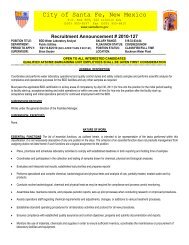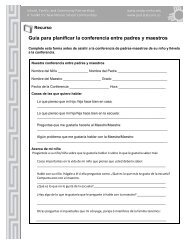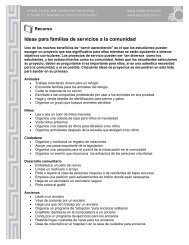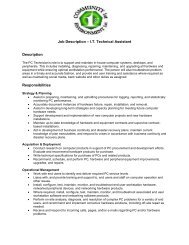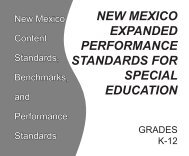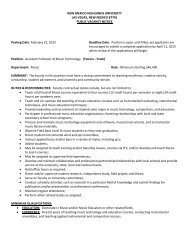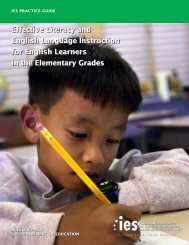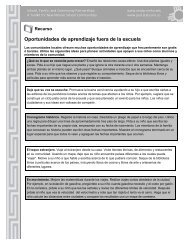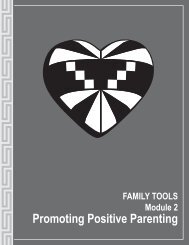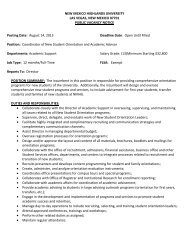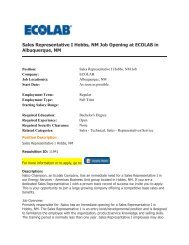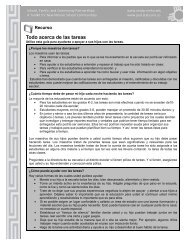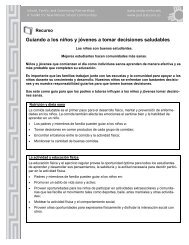MCNL - Center for the Education and Study of Diverse Populations
MCNL - Center for the Education and Study of Diverse Populations
MCNL - Center for the Education and Study of Diverse Populations
You also want an ePaper? Increase the reach of your titles
YUMPU automatically turns print PDFs into web optimized ePapers that Google loves.
New Mexico<br />
Content<br />
St<strong>and</strong>ards,<br />
Benchmarks,<br />
MODERN,<br />
CLASSICAL,<br />
AND NATIVE<br />
LANGUAGES<br />
<strong>and</strong><br />
Per<strong>for</strong>mance<br />
St<strong>and</strong>ards<br />
GRADES<br />
K-8
Modern, Classical <strong>and</strong> Native Languages Content St<strong>and</strong>ards<br />
“The person who learns two languages is worth two people.” – Miguel de Cervantes Saavedra<br />
The St<strong>and</strong>ards <strong>for</strong> Excellence set expectations <strong>for</strong> New Mexico students, <strong>and</strong> clearly state <strong>the</strong> pr<strong>of</strong>iciency in English is <strong>of</strong> <strong>the</strong><br />
highest importance. These Modern, Classical <strong>and</strong> Native Languages St<strong>and</strong>ards with Benchmarks align with <strong>the</strong> St<strong>and</strong>ards<br />
<strong>for</strong> Excellence by supporting <strong>the</strong> use <strong>of</strong> a student’s primary or home language, as appropriate, <strong>for</strong> teaching <strong>and</strong> learning<br />
while <strong>the</strong> student acquires pr<strong>of</strong>iciency in English.<br />
The Content St<strong>and</strong>ards <strong>for</strong> Modern, Classical <strong>and</strong> Native Languages were adopted as regulation by <strong>the</strong> New Mexico State<br />
Board <strong>of</strong> <strong>Education</strong> <strong>for</strong> grades K-8, <strong>and</strong> <strong>for</strong> elective courses chosen by students <strong>and</strong> <strong>the</strong>ir parents <strong>for</strong> grades 9-12. The<br />
Benchmarks are recommended <strong>for</strong> curricular guidance; <strong>the</strong>y should be integrated with <strong>the</strong> curriculum <strong>of</strong> <strong>the</strong> local school<br />
district.<br />
1. By speaking, writing, <strong>and</strong>/or signing, etc., students<br />
will express <strong>the</strong>mselves in a culturally appropriate<br />
manner <strong>for</strong> many purposes.<br />
2. By listening, observing, reading <strong>and</strong> discussing,<br />
students will comprehend <strong>and</strong> interpret oral, written,<br />
<strong>and</strong> visual messages on a variety <strong>of</strong> topics.<br />
3. Students will underst<strong>and</strong> <strong>the</strong> relationship between<br />
language <strong>and</strong> culture.<br />
4. Students will develop an underst<strong>and</strong>ing <strong>of</strong> o<strong>the</strong>r<br />
cultures, including such elements as: <strong>the</strong>ir<br />
value systems, languages, traditions, <strong>and</strong><br />
individual perspectives.<br />
5. Students will underst<strong>and</strong> how languages work.<br />
6. Students will use <strong>the</strong> languages studied to rein<strong>for</strong>ce<br />
<strong>and</strong> exp<strong>and</strong> knowledge <strong>of</strong> o<strong>the</strong>r disciplines.<br />
7. Students will use <strong>the</strong> languages studied <strong>for</strong> personal<br />
enjoyment, personal enrichment, <strong>and</strong> employability.<br />
<strong>MCNL</strong>
A. ACKNOWLEDGMENTS<br />
INTRODUCTION<br />
Members <strong>of</strong> <strong>the</strong> Per<strong>for</strong>mance St<strong>and</strong>ards Writing Committee met on September 2-3 <strong>and</strong> 12, 1997 to complete <strong>the</strong><br />
attached draft <strong>of</strong> Per<strong>for</strong>mance St<strong>and</strong>ards. We wish to thank Margo Chavez-Charles, Mary De López, Celeste<br />
Guillebaud, Nancy Lawrence, <strong>and</strong> Joanna Manygoats <strong>for</strong> <strong>the</strong>ir dedication <strong>and</strong> gracious assistance in working on this<br />
document. We also wish to thank Tina Lopez Snideman <strong>for</strong> her assistance in providing a work space.<br />
Guidance provided by <strong>the</strong> following three documents was most helpful: [The national] St<strong>and</strong>ards <strong>for</strong> Foreign<br />
Language Learning: Preparing <strong>for</strong> <strong>the</strong> 21 st Century (1996), College Board. Articulation <strong>and</strong> Achievement: Connecting<br />
St<strong>and</strong>ards, Per<strong>for</strong>mance, <strong>and</strong> Assessment in Foreign Language (1996), <strong>and</strong> Maine Department <strong>of</strong> <strong>Education</strong>.<br />
St<strong>and</strong>ards <strong>for</strong> Modern <strong>and</strong> Classical Languages (Internet publication).<br />
B. UNIFYING CONCEPTS IN MODERN, CLASSICAL AND NATIVE LANGUAGES EDUCATION<br />
The Writing Committee <strong>of</strong> <strong>the</strong> New Mexico Content St<strong>and</strong>ards <strong>and</strong> Benchmarks expressed <strong>the</strong> following statements<br />
<strong>for</strong> Modern, Classical, <strong>and</strong> Native Languages. They were published in <strong>the</strong> initial drafts <strong>of</strong> those Content St<strong>and</strong>ards<br />
<strong>and</strong> Benchmarks. Because <strong>the</strong>y were not part <strong>of</strong> <strong>the</strong> regulation <strong>of</strong> <strong>the</strong> New Mexico Content St<strong>and</strong>ards <strong>and</strong><br />
Benchmarks, we feel it is advisable to publish <strong>the</strong>m again as part <strong>of</strong> this curriculum guidance document.<br />
Unifying Concepts in Modern, Classical <strong>and</strong> Native Languages <strong>Education</strong><br />
1. Learning languages is important.<br />
Language <strong>and</strong> communication are at <strong>the</strong> heart <strong>of</strong> human experience. The skills <strong>of</strong> underst<strong>and</strong>ing <strong>and</strong> communicating<br />
with diverse linguistic <strong>and</strong> cultural groups are important <strong>for</strong> survival today, but <strong>the</strong>y will be vital in <strong>the</strong> 21 st century.<br />
While <strong>the</strong>se abilities will be essential <strong>for</strong> business, government, intellectual, <strong>and</strong> social interactions, <strong>the</strong> knowledge<br />
<strong>of</strong> languages also enhances learning in o<strong>the</strong>r disciplines <strong>and</strong> enriches life. All students should develop <strong>and</strong> maintain<br />
pr<strong>of</strong>iciency in English <strong>and</strong> in at least one o<strong>the</strong>r language.<br />
2. Culture is an integral part <strong>of</strong> communication.<br />
Language learning must include <strong>the</strong> study <strong>of</strong> culture <strong>and</strong> its effects on communication. All students should<br />
communicate successfully in a linguistically <strong>and</strong> culturally appropriate manner.
3. Languages are a community resource.<br />
The multicultural <strong>and</strong> multilingual communities <strong>of</strong> New Mexico provide rich <strong>and</strong> diverse resources <strong>for</strong> learning<br />
languages. New Mexicans must recognize, underst<strong>and</strong>, <strong>and</strong> value <strong>the</strong> unique qualities <strong>of</strong> various languages <strong>and</strong><br />
cultures, especially those native to <strong>the</strong> state: Native American languages, including Tewa, Tiwa, Towa, Keres, Zuni,<br />
<strong>and</strong> variants <strong>of</strong> Apache <strong>and</strong> Navajo; Spanish; <strong>and</strong> English.<br />
4. Successful acquisition <strong>of</strong> language is <strong>the</strong> product <strong>of</strong> a long-term, articulated program <strong>of</strong><br />
study.<br />
To be effective, a language program should span Kindergarten through Twelfth Grade <strong>and</strong>/or post-secondary levels <strong>of</strong><br />
education.<br />
C. AUTHENTIC COMMUNICATION<br />
(This section has been adapted from pages 97 <strong>and</strong> 98 <strong>of</strong> <strong>the</strong> National St<strong>and</strong>ards <strong>for</strong> Foreign Language Learning:<br />
Preparing <strong>for</strong> <strong>the</strong> 21 st Century, 1996.)<br />
In <strong>the</strong> past, “<strong>for</strong>eign” language instruction focused primarily on <strong>the</strong> memorization <strong>of</strong> words <strong>and</strong> grammar rules.<br />
Un<strong>for</strong>tunately, as generations <strong>of</strong> language students have taught us, grammar by itself does not produce individuals<br />
who can speak or underst<strong>and</strong> <strong>the</strong> language that <strong>the</strong>y study. “Foreign”/second languages are not acquired when<br />
students learn an ordered set <strong>of</strong> facts about <strong>the</strong> language (e.g., grammar facts, vocabulary). Students need to be<br />
able to use <strong>the</strong> target language <strong>for</strong> real communication; that is, to carry out a complex interactive process that<br />
involves speaking <strong>and</strong> underst<strong>and</strong>ing what o<strong>the</strong>rs say in <strong>the</strong> target language as well as reading <strong>and</strong> interpreting<br />
written materials <strong>and</strong> cultural aspects. Grammar is, never<strong>the</strong>less, important in <strong>the</strong> study <strong>of</strong> a language. For example,<br />
Content St<strong>and</strong>ard 5 (“Students will underst<strong>and</strong> how languages work.”) focuses on students’ underst<strong>and</strong>ing <strong>of</strong> <strong>the</strong><br />
nature <strong>of</strong> linguistic systems.<br />
D. INSTRUCTIONAL GUIDEPOSTS<br />
In order to achieve a communicative setting <strong>for</strong> language learners, teachers must create dynamic learning activities<br />
which focus attention on <strong>the</strong> functions <strong>of</strong> au<strong>the</strong>ntic (“real-world”) language. Quality in student per<strong>for</strong>mance is best<br />
attained in this type <strong>of</strong> interactive classroom. These activities also lend <strong>the</strong>mselves to research-based proven<br />
strategies.<br />
<strong>MCNL</strong>
Effective approaches include:<br />
• structured cooperative small group work, or partner/peer learning activities which facilitate negotiation <strong>of</strong><br />
meaning;<br />
• content which is cognitively challenging <strong>and</strong> presented through “sheltered” techniques, such as <strong>the</strong> use <strong>of</strong> a<br />
variety <strong>of</strong> visuals <strong>and</strong> realia; guarded vocabulary <strong>and</strong> accurate language modeling; small group tasks which<br />
require problem-solving <strong>and</strong> discovery learning; <strong>and</strong> h<strong>and</strong>s-on learning experiences using concrete examples<br />
to illustrate abstract concepts;<br />
• focused, brief direct instruction <strong>of</strong> concepts <strong>and</strong> skills, complemented by abundant individual <strong>and</strong> collaborative<br />
student-centered practice;<br />
• language activities which address many learning styles including TPR (“Total Physical Response” – an approach<br />
to language learning that emphasizes a dramatic association <strong>of</strong> <strong>the</strong> whole body with language learning),<br />
multi-sensory projects (e.g., art, drama, music), “whole-to-part” <strong>and</strong> “part-to- whole” instruction <strong>and</strong> activities, <strong>and</strong><br />
<strong>the</strong> making <strong>of</strong> graphs, charts, <strong>and</strong> tables;<br />
• notational/ functional <strong>and</strong> <strong>the</strong>matic approaches, which integrate vocabulary <strong>and</strong> grammar acquisition into <strong>the</strong><br />
communication needs <strong>of</strong> students;<br />
• use <strong>of</strong> learning/study strategies such as mental rehearsal, researching, making inferences, positive self-talk,<br />
collaboration, <strong>and</strong> questioning <strong>for</strong> clarification.<br />
The New Mexico Modern, Classical <strong>and</strong> Native Languages Content St<strong>and</strong>ards require a much broader definition <strong>of</strong><br />
language study in which students are given opportunities to explore, develop, <strong>and</strong> use communication strategies,<br />
learning strategies, <strong>and</strong> critical thinking skills, as well as <strong>the</strong> appropriate elements <strong>of</strong> <strong>the</strong> language system <strong>and</strong> culture.
Content St<strong>and</strong>ards For Modern, Classical<br />
And Native Languages <strong>Education</strong><br />
Content St<strong>and</strong>ard 1: By speaking, writing, <strong>and</strong>/or signing, etc., students will express<br />
<strong>the</strong>mselves in a culturally appropriate manner <strong>for</strong> many<br />
purposes.<br />
Content St<strong>and</strong>ard 2: By listening, observing, reading <strong>and</strong> discussing, students will<br />
comprehend <strong>and</strong> interpret oral, written, <strong>and</strong> visual messages on<br />
a variety <strong>of</strong> topics.<br />
Content St<strong>and</strong>ard 3: Students will underst<strong>and</strong> <strong>the</strong> relationship between language<br />
<strong>and</strong> culture.<br />
Content St<strong>and</strong>ard 4: Students will develop an underst<strong>and</strong>ing <strong>of</strong> o<strong>the</strong>r cultures,<br />
including such elements as: <strong>the</strong>ir value systems, languages,<br />
traditions, <strong>and</strong> individual perspectives.<br />
Content St<strong>and</strong>ard 5: Students will underst<strong>and</strong> how languages work.<br />
Content St<strong>and</strong>ard 6: Students will use <strong>the</strong> languages studied to rein<strong>for</strong>ce <strong>and</strong><br />
exp<strong>and</strong> knowledge <strong>of</strong> o<strong>the</strong>r disciplines.<br />
Content St<strong>and</strong>ard 7: Students will use <strong>the</strong> languages studied <strong>for</strong> personal enjoyment,<br />
personal enrichment, <strong>and</strong> employability.<br />
<strong>MCNL</strong>
CONTENT STANDARD 1: By speaking, writing, <strong>and</strong>/or signing, students will<br />
express <strong>the</strong>mselves in a culturally appropriate manner <strong>for</strong> many purposes.<br />
Grade K-4<br />
BENCHMARK<br />
PERFORMANCE STANDARDS<br />
In <strong>the</strong><br />
language(s)<br />
studied,<br />
students<br />
will:<br />
A. Express likes <strong>and</strong> dislikes on topics that are <strong>of</strong> concern <strong>and</strong> interest to <strong>the</strong>m, with <strong>the</strong>ir peers <strong>and</strong> in<br />
<strong>the</strong> classroom.<br />
1. Converse, write briefly, <strong>and</strong> ask/ answer simple questions about <strong>the</strong>mselves <strong>and</strong> <strong>the</strong>ir immediate<br />
environment:<br />
a. Participate in oral “show <strong>and</strong> tell” exercises.<br />
b. Play games.<br />
c. Talk with classmates about pets, favorite foods, families, etc.<br />
d. Compile a bilingual dictionary.<br />
B. Participate in <strong>and</strong> recognize various <strong>for</strong>ms <strong>of</strong> cultural expression such as: music, art, speech, writing,<br />
traditions, <strong>and</strong> o<strong>the</strong>r products <strong>of</strong> <strong>the</strong> culture.<br />
1. Participate in various <strong>for</strong>ms <strong>of</strong> cultural expression including: music <strong>and</strong> dance, art, storytelling,<br />
writing, traditional celebrations, <strong>and</strong> making artifacts <strong>of</strong> a culture (foods, costumes, games, toys,<br />
books, etc.):<br />
a. Per<strong>for</strong>m a dance or song from <strong>the</strong> culture studied.<br />
b. Use a work <strong>of</strong> visual art from <strong>the</strong> language/ culture studied as <strong>the</strong> basis <strong>for</strong> a written<br />
descriptive paragraph <strong>and</strong>/or a poem.<br />
c. Tell a story in <strong>the</strong> language studied orally <strong>and</strong> in writing.<br />
d. Use a literary work from <strong>the</strong> language/ culture studied to create a drama, a song, or a dance.<br />
e. Produce <strong>and</strong> share a meal from <strong>the</strong> culture studied.<br />
f. Participate in <strong>and</strong> describe a traditional celebration <strong>of</strong> <strong>the</strong> culture studied including: foods,<br />
language, costume, music, drama, etc.<br />
g. Play games <strong>of</strong> <strong>the</strong> culture studied.<br />
h. Observe arts <strong>and</strong>/or crafts <strong>of</strong> <strong>the</strong> culture studied, participate in making samples <strong>of</strong> <strong>the</strong>m.
Grade 5-8<br />
BENCHMARK<br />
PERFORMANCE STANDARDS<br />
In <strong>the</strong><br />
language(s)<br />
studied,<br />
students<br />
will:<br />
A. Express thoughts on topics that are <strong>of</strong> concern <strong>and</strong> interest to <strong>the</strong>m within <strong>the</strong>ir school <strong>and</strong> community.<br />
1. Converse <strong>and</strong> write about; ask <strong>and</strong> answer questions about; <strong>and</strong> compare <strong>and</strong> contrast things<br />
<strong>and</strong> events in <strong>the</strong>ir school life, in school subjects, <strong>and</strong> in <strong>the</strong>ir local community:<br />
a. Create a map <strong>of</strong> one’s own neighborhood <strong>and</strong> describe it to <strong>the</strong> class.<br />
b. Keep a diary on a day at school.<br />
c. In correspondence with a pen pal, compare daily lives.<br />
d. Plan <strong>and</strong> carry out an extracurricular activity with <strong>the</strong> class.<br />
e. Make a videotape or photographic program about a tradition <strong>of</strong> <strong>the</strong> culture studied.<br />
f. Design, draw <strong>and</strong> discuss one’s house plan or a diorama <strong>of</strong> one’s town.<br />
B. Participate in <strong>and</strong> interpret various <strong>for</strong>ms <strong>of</strong> Cultural expression such as: music, art, speech, writing,<br />
traditions, <strong>and</strong> o<strong>the</strong>r products <strong>of</strong> a culture.<br />
1. Express orally or in writing what was learned by participating in a cultural event:<br />
a. In a group, research <strong>and</strong> report in writing <strong>and</strong> orally about an important tradition <strong>of</strong> <strong>the</strong> culture<br />
studied.<br />
b. In a group, plan <strong>and</strong> carry out a school “Culture Fair Day.”<br />
c. Memorize <strong>and</strong> recite a poem from <strong>the</strong> culture studied <strong>and</strong> explain what it is about.<br />
<strong>MCNL</strong>
CONTENT STANDARD 2: By listening, observing, reading <strong>and</strong> discussing,<br />
students will comprehend <strong>and</strong> interpret oral, written, <strong>and</strong> visual messages on a<br />
variety <strong>of</strong> topics.<br />
Grade K-4<br />
BENCHMARK<br />
PERFORMANCE STANDARDS<br />
In <strong>the</strong><br />
language(s)<br />
studied,<br />
students<br />
will:<br />
A. Comprehend in<strong>for</strong>mation on topics <strong>of</strong> concern <strong>and</strong> interest to <strong>the</strong>m.<br />
1. Using a variety <strong>of</strong> sources, observe <strong>and</strong> correctly interpret in<strong>for</strong>mation presented in <strong>the</strong> language<br />
studied:<br />
a. Observe/listen to <strong>and</strong> explain/retell simple narratives presented in a variety <strong>of</strong> <strong>for</strong>mats such as<br />
newspapers, letters, literature, newscasts, videos, musical recordings <strong>and</strong> conversations.<br />
b. Repeat, follow, <strong>and</strong> give directions.<br />
c. Recognize <strong>and</strong> identify names <strong>of</strong> objects.<br />
B. Recognize <strong>for</strong>ms <strong>of</strong> cultural expression such as: music art, speech, writing, traditions, <strong>and</strong> o<strong>the</strong>r<br />
products <strong>of</strong> a culture.<br />
1. Identify <strong>and</strong> associate <strong>the</strong> language studied with many <strong>for</strong>ms <strong>of</strong> cultural expression, including:<br />
dress, holidays, food, <strong>and</strong> music <strong>of</strong> an appropriate country or region:<br />
a. Per<strong>for</strong>m a song or tell a folktale in <strong>the</strong> language studied.<br />
b. Prepare a typical meal <strong>of</strong> <strong>the</strong> region or country <strong>and</strong> prepare a menu in <strong>the</strong> language studied.<br />
c. Identify types <strong>of</strong> art works, crafts, or graphic representations enjoyed or made by <strong>the</strong> student’s<br />
peer group within <strong>the</strong> culture studied.<br />
C. Demonstrate awareness <strong>of</strong> different elements <strong>of</strong> communication, both verbal <strong>and</strong> non-verbal:<br />
1. Correctly interpret in<strong>for</strong>mation, using language <strong>and</strong> facial, voice (tone <strong>and</strong> intonation),<br />
expressions, dress, gestures <strong>and</strong> o<strong>the</strong>r body language:<br />
a. Model/mimic/imitate common gestures from <strong>the</strong> language/cultures studied.<br />
b. Respond appropriately to a variety <strong>of</strong> oral comm<strong>and</strong>s, questions, <strong>and</strong> nonverbal messages.
Grade 5-8<br />
BENCHMARK<br />
PERFORMANCE STANDARDS<br />
In <strong>the</strong><br />
language(s)<br />
studied,<br />
students<br />
will:<br />
A. Comprehend in<strong>for</strong>mation on topics <strong>of</strong> concern <strong>and</strong> interest to <strong>the</strong>m, <strong>the</strong>ir school <strong>and</strong> <strong>the</strong>ir community.<br />
1. Obtain in<strong>for</strong>mation from “au<strong>the</strong>ntic resources” (e.g., resources that portray or are derived<br />
from real life experiences <strong>and</strong> original sources <strong>of</strong> <strong>the</strong> language/culture studied), acquire<br />
new knowledge about people, events, <strong>and</strong> cultures, <strong>and</strong> demonstrate comprehension by means<br />
<strong>of</strong> presentations in written, oral <strong>and</strong>/or o<strong>the</strong>r artistic <strong>for</strong>ms:<br />
a. Read a newspaper in <strong>the</strong> language studied <strong>and</strong> summarize in oral/written/ or sign language<br />
what was read.<br />
b. Observe an event or dramatization, live or via a media <strong>for</strong>m, <strong>and</strong> write or illustrate a report<br />
about it.<br />
c. Read a pen pal’s letter in <strong>the</strong> language studied, <strong>and</strong> report to class. Compare <strong>and</strong> contrast <strong>the</strong><br />
in<strong>for</strong>mation with in<strong>for</strong>mation about <strong>the</strong> student’s home, school, <strong>and</strong> community.<br />
B. Recognize <strong>and</strong> interpret more complex <strong>for</strong>ms <strong>of</strong> cultural expression.<br />
1. Observe, describe, <strong>and</strong> discuss patterns <strong>of</strong> behavior, <strong>of</strong> artistic expression, <strong>and</strong> <strong>of</strong> use <strong>of</strong><br />
materials <strong>of</strong> <strong>the</strong> culture studied:<br />
a. Compare <strong>and</strong> contrast behavior typical <strong>of</strong> <strong>the</strong> student’s peer group in <strong>the</strong> culture studied.<br />
b. Identify heroes, heroines, <strong>and</strong> myths <strong>of</strong> <strong>the</strong> culture studied.<br />
c. Describe, compare <strong>and</strong> contrast objects <strong>and</strong> decor in a peer’s bedroom in <strong>the</strong> culture studied.<br />
<strong>MCNL</strong>
CONTENT STANDARD 3: Students will underst<strong>and</strong> <strong>the</strong> relationship between<br />
language <strong>and</strong> culture.<br />
Grade K-4<br />
BENCHMARK<br />
PERFORMANCE STANDARDS<br />
In <strong>the</strong><br />
language(s)<br />
studied,<br />
students<br />
will:<br />
A. Demonstrate simple language patterns, gestures <strong>and</strong> oral expressions in common interactions.<br />
1. Use appropriate courtesy expressions <strong>for</strong> simple everyday tasks, such as: greetings,<br />
introductions, gestures, behavior during meals, etc. This includes use <strong>of</strong> <strong>for</strong>mal <strong>and</strong> in<strong>for</strong>mal<br />
language, intonations, etc.:<br />
a. Role-play appropriate greetings <strong>and</strong> introductions.<br />
b. Role-play ordering a meal.<br />
B. Recognize socially <strong>and</strong> culturally acceptable language <strong>and</strong> behavior.<br />
1. Presented with a variety <strong>of</strong> social behaviors, select behaviors appropriate <strong>for</strong> <strong>the</strong> culture <strong>and</strong><br />
situation:<br />
a. Identify <strong>the</strong> appropriate <strong>for</strong>m <strong>of</strong> address to use with an elder.<br />
b. Use appropriate gestures in a <strong>for</strong>mal situation.<br />
c. Use appropriate language <strong>and</strong> gestures when eating a meal.
Grade 5-8<br />
BENCHMARK<br />
PERFORMANCE STANDARDS<br />
In <strong>the</strong><br />
language(s)<br />
studied,<br />
students<br />
will:<br />
A. Use appropriate language <strong>and</strong> gestures which reflect cultural underst<strong>and</strong>ing <strong>and</strong> meaning.<br />
1. Observe, recognize, compare <strong>and</strong> contrast, <strong>and</strong> use appropriate behavior including gestures,<br />
personal space, body language, <strong>and</strong> age-, class-, <strong>and</strong> gender-appropriate behaviors <strong>for</strong> <strong>the</strong><br />
culture studied:<br />
a. Role-play making a request <strong>of</strong> peers or elders.<br />
b. Write a “Dear Abbie” letter describing a misunderst<strong>and</strong>ing resulting from culturally<br />
inappropriate behavior.<br />
c. Compile <strong>and</strong> illustrate a dictionary <strong>of</strong> cultural gestures.<br />
B. Demonstrate how language influences culture.<br />
1. Use appropriate language reflecting culture, including: register, <strong>for</strong>mal/in<strong>for</strong>mal address,<br />
distinctions <strong>of</strong> time, gender, age, <strong>and</strong> human/non-human status:<br />
a. Create cartoon strips to illustrate slang expressions.<br />
b. Write a poem using words that distinguish between humans <strong>and</strong> animals.<br />
c. Research <strong>and</strong> discuss taboos <strong>of</strong> language <strong>and</strong>/or gestures <strong>of</strong> <strong>the</strong> language <strong>and</strong> culture<br />
studied.<br />
d. Use appropriate language when addressing teachers, guests, <strong>and</strong> peers in <strong>the</strong> classroom.<br />
<strong>MCNL</strong>
CONTENT STANDARD 4: Students will develop an underst<strong>and</strong>ing <strong>of</strong> o<strong>the</strong>r<br />
cultures, including such elements as: value systems, languages, traditions,<br />
<strong>and</strong> individual perspectives.<br />
Grade K-4<br />
BENCHMARK<br />
PERFORMANCE STANDARDS<br />
In <strong>the</strong><br />
language(s)<br />
studied,<br />
students<br />
will:<br />
A. Recognize <strong>and</strong> demonstrate <strong>the</strong> elements <strong>of</strong> a cultural system.<br />
1. Identify/describe elements <strong>of</strong> culture (i.e., what identifies members <strong>of</strong> a cultural group):<br />
a. Tell/re-tell stories.<br />
b. Role-play a family meal.<br />
c. Role-play shopping/ exchange <strong>of</strong> goods.<br />
d. Role-play a celebration <strong>of</strong> <strong>the</strong> culture studied, using appropriate dress <strong>and</strong> behavior.<br />
e. Participate in dances, sports <strong>and</strong> games <strong>of</strong> <strong>the</strong> culture studied.<br />
f. Illustrate “a day in <strong>the</strong> life” <strong>of</strong> a peer in <strong>the</strong> culture studied, showing house, family tree,<br />
geography, environment, transportation, value systems (by items in <strong>the</strong> house), humor style,<br />
<strong>and</strong> o<strong>the</strong>r social practices (such as gift-giving).<br />
B. Recognize <strong>the</strong> cultural variations within a linguistic group.<br />
1. Recognize differences in ways <strong>of</strong> life/ “lifestyles” within one language group:<br />
a. Compare celebrations in two countries or regions that share <strong>the</strong> same language.<br />
b. Compare foods in two countries or regions that share <strong>the</strong> same language.<br />
c. Compile a dictionary <strong>of</strong> slang or regional dialect <strong>for</strong> two countries or regions that share <strong>the</strong><br />
same <strong>for</strong>mal language.<br />
d. Identify <strong>and</strong> describe <strong>the</strong> geographical locations <strong>and</strong> environments <strong>of</strong> two different countries or<br />
regions that share <strong>the</strong> same language.
Grade 5-8<br />
BENCHMARK<br />
PERFORMANCE STANDARDS<br />
In <strong>the</strong><br />
language(s)<br />
studied,<br />
students<br />
will:<br />
A. Exp<strong>and</strong> <strong>and</strong> apply knowledge <strong>of</strong> <strong>the</strong> elements <strong>of</strong> a cultural system.<br />
1. Investigate stereotypes <strong>of</strong> a culture using different <strong>for</strong>ms <strong>of</strong> media/communication:<br />
a. Use e-mail/ Internet to survey members <strong>of</strong> a culture.<br />
b. Investigate stereotypes <strong>of</strong> a culture by keeping a journal <strong>of</strong> observations about <strong>the</strong> culture as<br />
published in <strong>the</strong> mass media.<br />
c. Research <strong>and</strong> report on (compare <strong>and</strong> contrast) traditions <strong>and</strong> institutions <strong>of</strong> two different<br />
cultures regarding: governments, schools, religions, art <strong>for</strong>ms, <strong>for</strong>ms <strong>of</strong> work, <strong>for</strong>ms <strong>of</strong> childrearing,<br />
societal rules, <strong>and</strong>/or leisure activities including sports.<br />
d. Produce a videotape about stereotypes <strong>of</strong> a culture.<br />
e. Research <strong>and</strong> report on current trends <strong>and</strong> events in <strong>the</strong> culture studied, especially those in<br />
popular media describing <strong>the</strong> student’s own age group.<br />
f. Research <strong>and</strong> report on <strong>the</strong> archaeology, history <strong>and</strong>/or biography <strong>of</strong> a culture<br />
(“Who are/ who were important people <strong>and</strong> why”).<br />
g. Research <strong>and</strong> report on <strong>the</strong> geography <strong>and</strong> biology <strong>of</strong> <strong>the</strong> culture studied.<br />
B. Exp<strong>and</strong> <strong>and</strong> use knowledge <strong>of</strong> <strong>the</strong> cultural variations within a linguistic group.<br />
1. Compare <strong>and</strong> contrast differences <strong>and</strong> similarities between speakers <strong>of</strong> <strong>the</strong> same language by<br />
researching <strong>and</strong> reporting on <strong>the</strong>ir history(ies),societal rules <strong>and</strong> roles:<br />
a. Using books, periodical articles, videotapes, films, or field trips, observe <strong>and</strong> report on<br />
differences <strong>and</strong> similarities <strong>of</strong> men <strong>and</strong> women in <strong>the</strong>ir daily lives in two countries or regions<br />
that share <strong>the</strong> same language.<br />
b. Record <strong>and</strong> compare differences <strong>and</strong> similarities-in dialect, idioms, <strong>and</strong> o<strong>the</strong>r language<br />
styles-<strong>of</strong> storytellers from two countries or regions that share <strong>the</strong> same language.<br />
2. Produce written <strong>and</strong> illustrated materials that are aimed at a particular population as <strong>the</strong> audience,<br />
using <strong>the</strong> language studied:<br />
a. Write <strong>and</strong> produce a public service announcement <strong>for</strong> a particular population<br />
audience using <strong>the</strong> language <strong>and</strong> dialect studied.<br />
b. Write <strong>and</strong> deliver a political campaign speech that is aimed at a particular population<br />
audience, using <strong>the</strong> language <strong>and</strong> dialect studied.<br />
c. Design an advertising campaign that uses local dialect in <strong>the</strong> slogans.<br />
<strong>MCNL</strong>
CONTENT STANDARD 5: Students will underst<strong>and</strong> how languages work.<br />
Grade K-4<br />
BENCHMARK<br />
PERFORMANCE STANDARDS<br />
In <strong>the</strong><br />
language(s)<br />
studied,<br />
students<br />
will:<br />
A. Recognize that different languages use different patterns to communicate.<br />
1. Listen, read, <strong>and</strong> respond appropriately in <strong>the</strong> language studied to conversations, comm<strong>and</strong>s,<br />
<strong>and</strong> questions that use different patterns from <strong>the</strong> first language:<br />
a. Role-play appropriate greetings <strong>and</strong> introductions.<br />
b. Role-play ordering a meal.<br />
c. Role-play a visit to <strong>the</strong> doctor.<br />
2. Listen, read, <strong>and</strong> respond appropriately in <strong>the</strong> language studied to folk <strong>and</strong> o<strong>the</strong>r literary works<br />
that use different patterns from <strong>the</strong> first language:<br />
a. Role-play stories <strong>and</strong> dialogues.<br />
b. Tell <strong>and</strong> retell stories.<br />
c. Draw interpretations <strong>of</strong> stories <strong>and</strong> poems from <strong>the</strong> language studied.<br />
3. Compare <strong>and</strong> contrast linguistic <strong>and</strong> literary elements in <strong>the</strong> language studied with those in <strong>the</strong><br />
student’s home language:<br />
a. Compare idioms, proverbs, <strong>and</strong> o<strong>the</strong>r folk sayings in <strong>the</strong> language studied with those <strong>of</strong> <strong>the</strong><br />
first language.<br />
b. Listen, read, retell <strong>and</strong> illustrate stories, poems, proverbs <strong>and</strong> o<strong>the</strong>r folk literature from <strong>the</strong><br />
language studied in <strong>the</strong> student’s first language.<br />
c. Compare intonation patterns <strong>of</strong> <strong>the</strong> language studied with <strong>the</strong> intonation patterns <strong>of</strong> <strong>the</strong> first<br />
language.<br />
d. Compose a musical piece or poem using <strong>the</strong> intonation patterns <strong>of</strong> <strong>the</strong> language studied.
In <strong>the</strong><br />
language(s)<br />
studied,<br />
students<br />
will:<br />
B. Become aware <strong>of</strong> <strong>the</strong> various levels <strong>and</strong> styles <strong>of</strong> language.<br />
1. Listen, read, <strong>and</strong> respond appropriately in <strong>the</strong> language studied to conversation <strong>and</strong> presentations<br />
that use styles <strong>and</strong> levels that are different from those <strong>of</strong> <strong>the</strong> student’s first language:<br />
a. Listen to, read, <strong>and</strong> compare folk <strong>and</strong> fairy tales from <strong>the</strong> language studied <strong>and</strong> <strong>the</strong> student’s<br />
first language.<br />
b. View, listen to, <strong>and</strong> respond appropriately to questions about a soap opera or drama<br />
per<strong>for</strong>med in <strong>the</strong> language studied.<br />
c. View, listen to, <strong>and</strong> respond appropriately to questions about an advertisement presented in<br />
<strong>the</strong> language studied.<br />
d. Write a letter to a pen pal in <strong>the</strong> language studied.<br />
C. Compare <strong>the</strong> critical elements <strong>of</strong> <strong>the</strong> language systems studied with <strong>the</strong> elements <strong>of</strong> <strong>the</strong> student’s<br />
own language.<br />
1. Compare sounds <strong>and</strong> rules <strong>of</strong> <strong>the</strong> language studied with those <strong>of</strong> <strong>the</strong> first language:<br />
a. Interpret idioms <strong>of</strong> <strong>the</strong> language studied.<br />
b. Respond to questions without making a literal translation.<br />
c. Compare alphabets, <strong>the</strong>ir pronunciation <strong>and</strong> application, <strong>and</strong> writing <strong>for</strong>ms used in<br />
<strong>the</strong> two languages.<br />
d. Compare expressions <strong>for</strong> wea<strong>the</strong>r, feelings, time, states <strong>of</strong> being, actions, <strong>and</strong> uses <strong>of</strong><br />
articles, pronouns, etc. in <strong>the</strong> two languages.<br />
<strong>MCNL</strong>
Grade 5-8<br />
BENCHMARK<br />
PERFORMANCE STANDARDS<br />
In <strong>the</strong><br />
language(s)<br />
studied,<br />
students<br />
will:<br />
A. Recognize <strong>and</strong> use <strong>the</strong> most common patterns <strong>of</strong> <strong>the</strong> languages studied.<br />
1. Use different sentence modes in conversation (imperative, interrogative, declarative,<br />
exclamatory).<br />
a. Create a skit <strong>and</strong> per<strong>for</strong>m it (live, on radio or on a videotape).<br />
b. Interview a native speaker correctly using questions in <strong>the</strong> language studied.<br />
B. Recognize <strong>and</strong> use <strong>the</strong> appropriate levels <strong>and</strong> styles <strong>of</strong> language in various contexts<br />
1. Write dialogues <strong>for</strong> <strong>and</strong> per<strong>for</strong>m characters in dramatizations showing different<br />
contexts/situations:<br />
a. Observe soap opera video segments to analyze levels <strong>and</strong> styles <strong>of</strong> <strong>the</strong> language studied,<br />
such as greetings in different situations, roles, etc.<br />
b. Read selections <strong>of</strong> dialogues <strong>and</strong> determine roles <strong>and</strong> situations.<br />
c. Listen to, read, <strong>and</strong> write ballads in <strong>the</strong> language studied.<br />
d. Using <strong>the</strong> language studied, write a <strong>for</strong>mal letter inquiring on a subject <strong>of</strong> interest to a<br />
consulate or embassy.
In <strong>the</strong><br />
language(s)<br />
studied,<br />
students<br />
will:<br />
C. Interpret <strong>and</strong> apply critical elements <strong>of</strong> <strong>the</strong> language systems studied to communicate meaning.<br />
1. Comprehend <strong>and</strong> use correctly critical elements <strong>of</strong> <strong>the</strong> language studied, including:<br />
a. phonemes, tense markers,<br />
b. mood markers,<br />
c. voice,<br />
d. person,<br />
e. syntax-word order <strong>and</strong> placement,<br />
f. patterns,<br />
g. number,<br />
h. gender,<br />
i. diacritical marks,<br />
j. punctuation,<br />
k. mechanics,<br />
l. word functions,<br />
m. intonation,<br />
n. cadence,<br />
o. pronunciation.<br />
<strong>MCNL</strong>
CONTENT STANDARD 6: Students will use <strong>the</strong> languages studied to rein<strong>for</strong>ce<br />
<strong>and</strong> exp<strong>and</strong> knowledge <strong>of</strong> o<strong>the</strong>r disciplines.<br />
Grade K-4<br />
BENCHMARK<br />
PERFORMANCE STANDARDS<br />
In <strong>the</strong><br />
language(s)<br />
studied,<br />
students<br />
will:<br />
A. Apply in<strong>for</strong>mation from <strong>the</strong> languages studied to o<strong>the</strong>r content areas.<br />
1. Tell/show/teach vocabulary from <strong>the</strong> language studied when studying o<strong>the</strong>r content areas:<br />
a. Count numbers.<br />
b. Create a word-picture vocabulary book/dictionary showing <strong>the</strong> use <strong>of</strong> words in a related<br />
subject.<br />
c. Explain <strong>the</strong> use <strong>of</strong> words from <strong>the</strong> language studied in a story or in<strong>for</strong>mation presentation in<br />
ano<strong>the</strong>r subject.<br />
d. Apply words from <strong>the</strong> language studied in experiments, games, geography, role-playing,<br />
making a bilingual illustration, stories, poems, recipe book, menu, science classifications, etc.<br />
B. Connect experiences <strong>and</strong> new knowledge from o<strong>the</strong>r content areas to what is being learned in <strong>the</strong><br />
languages studied.<br />
1. Make posters, displays, dioramas, <strong>and</strong> o<strong>the</strong>r media products in <strong>the</strong> language studied:<br />
a. Write <strong>and</strong> make a public service announcement <strong>for</strong> health or o<strong>the</strong>r community benefit, using<br />
<strong>the</strong> language studied.<br />
b. Design an advertising campaign to sell a product or service, using <strong>the</strong> language studied in <strong>the</strong><br />
slogans.<br />
2. Connect experiences <strong>and</strong> concepts learned in o<strong>the</strong>r content areas to learning in <strong>the</strong> language<br />
culture studied:<br />
a. Connect social experiences <strong>and</strong> knowledge <strong>of</strong> family customs, arts, traditions, <strong>and</strong> etiquette to<br />
enhance learning in <strong>the</strong> language/ culture studied.<br />
b. Design <strong>and</strong> present a menu, dictionary, or glossary <strong>of</strong> terms in a related subject that uses<br />
words <strong>and</strong>/or concepts from <strong>the</strong> language/ culture studied.<br />
c. Using geographical resources such as globes, maps, atlases <strong>and</strong> gazetteers, identify <strong>and</strong><br />
describe <strong>the</strong> location <strong>and</strong> environment <strong>of</strong> one country or region where <strong>the</strong> language studied<br />
is spoken.
Grade 5-8<br />
BENCHMARK<br />
PERFORMANCE STANDARDS<br />
In <strong>the</strong><br />
language(s)<br />
studied,<br />
students<br />
will:<br />
A. Access <strong>and</strong> use in<strong>for</strong>mation from <strong>the</strong> languages studied in o<strong>the</strong>r content areas.<br />
1. Using in<strong>for</strong>mation/ media sources written or spoken in <strong>the</strong> language studied, access <strong>and</strong> present<br />
in<strong>for</strong>mation about topics in o<strong>the</strong>r content areas:<br />
a. Listen to <strong>and</strong> report on radio <strong>and</strong> television news reports <strong>of</strong> current events delivered in <strong>the</strong><br />
language studied.<br />
b. Interview a native speaker about a hobby <strong>of</strong> mutual interest.<br />
c. Participate in a group interdisciplinary project that incorporates <strong>the</strong> language studied, such<br />
as a problem-solving project on environment, economics, history, art, music, medicine,<br />
engineering, architecture, etc. Use <strong>the</strong> language studied in <strong>the</strong> project.<br />
d. Plan <strong>and</strong> go on a field trip <strong>for</strong> ano<strong>the</strong>r subject to a region that speaks <strong>the</strong> language studied.<br />
Design a map <strong>of</strong> <strong>the</strong> area using <strong>the</strong> language studied, <strong>and</strong> use <strong>the</strong> language in <strong>the</strong> logging<br />
<strong>of</strong> field notes.<br />
e. Compile <strong>and</strong> present an illustrated program about <strong>the</strong> influence <strong>of</strong> <strong>the</strong> language studied on<br />
culinary arts, visual arts, on political science <strong>and</strong> government (e.g., French: “crème de la<br />
crème,” “chef,” “trompe l’oeuil,” “Coup d’etat,”etc.<br />
<strong>MCNL</strong>
In <strong>the</strong><br />
language(s)<br />
studied,<br />
students<br />
will:<br />
B. Compare experiences <strong>and</strong> new knowledge from o<strong>the</strong>r content areas to what is being learned in <strong>the</strong><br />
languages studied.<br />
1. Compare folk <strong>and</strong> written literatures <strong>of</strong> <strong>the</strong> language studied with <strong>the</strong> literature <strong>of</strong> <strong>the</strong> student’s<br />
first language:<br />
a. Trace <strong>the</strong> development <strong>of</strong> urban legends in <strong>the</strong> language studied <strong>and</strong> compare <strong>and</strong> contrast<br />
<strong>the</strong>m with urban legends in <strong>the</strong> first language.<br />
b. Compare periodicals or national propag<strong>and</strong>a from one country that uses <strong>the</strong> language studied<br />
with similar literature from a country <strong>of</strong> <strong>the</strong> student’s first language.<br />
c. Compare popular songs <strong>and</strong> dances from <strong>the</strong> country/language studied with songs <strong>and</strong><br />
dances <strong>of</strong> <strong>the</strong> country <strong>of</strong> <strong>the</strong> student’s first language, etc.<br />
2. Apply concepts, vocabulary <strong>and</strong> in<strong>for</strong>mation from o<strong>the</strong>r content areas to learning in<br />
<strong>the</strong> language studied:<br />
a. Use terms from <strong>the</strong> arts or sciences to explain <strong>and</strong> illustrate vocabulary <strong>and</strong> word roots in<br />
<strong>the</strong> language studied.<br />
b. Use concepts, vocabulary, in<strong>for</strong>mation, <strong>and</strong> processes from technology <strong>and</strong> media production<br />
in <strong>the</strong> presentation <strong>of</strong> programs about <strong>the</strong> language studied.
CONTENT STANDARD 7: Students will use <strong>the</strong> language studied <strong>for</strong> personal<br />
enjoyment, personal enrichment, <strong>and</strong> employability.<br />
Grade K-4<br />
BENCHMARK<br />
PERFORMANCE STANDARDS<br />
In <strong>the</strong><br />
language(s)<br />
studied,<br />
students<br />
will:<br />
A. Use languages <strong>and</strong> knowledge <strong>of</strong> cultures to share personal experiences, feelings, <strong>and</strong> decisions.<br />
1. Share one’s own knowledge, feelings, <strong>and</strong> skills in studying language <strong>and</strong> culture:<br />
a. Show <strong>and</strong> tell about one’s own family life, celebrations, traditions, crafts, <strong>and</strong> skills <strong>and</strong><br />
compare <strong>the</strong>m to <strong>the</strong> language/ culture studied.<br />
b. Write or produce a slide-tape or videotape version <strong>of</strong> an autobiography.<br />
c. Learn/ teach songs from <strong>the</strong>ir culture <strong>and</strong> from <strong>the</strong> culture studied.<br />
d. Write concrete poems in <strong>the</strong> language studied expressing each student’s likes <strong>and</strong> dislikes.<br />
B. Apply languages <strong>and</strong> knowledge <strong>of</strong> cultures <strong>for</strong> recreation, creative expression, <strong>and</strong> social interaction<br />
beyond <strong>the</strong> instructional setting.<br />
1. Share celebration <strong>of</strong> <strong>the</strong> arts <strong>of</strong> <strong>the</strong> culture studied:<br />
a. Teach songs, dances <strong>and</strong> vocabulary <strong>the</strong>y have learned to <strong>the</strong>ir families.<br />
b. Bring products <strong>of</strong> creative expression to share at home.<br />
c. Present a public per<strong>for</strong>mance using <strong>the</strong> language studied.<br />
d. Participate in field trips to community agencies, museums <strong>and</strong> events <strong>of</strong> <strong>the</strong> culture studied.<br />
e. Listen <strong>and</strong> retell folktales from/in <strong>the</strong> language studied.<br />
f. Record stories told in <strong>the</strong> language studied.<br />
C. Use languages <strong>and</strong> knowledge <strong>of</strong> cultures to become aware <strong>of</strong> career opportunities.<br />
1. Learn about careers using <strong>the</strong> language studied:<br />
a. Interview visitors/ guest speakers.<br />
b. Make picture books about careers as part <strong>of</strong> researching about <strong>the</strong>m using library resources.<br />
c. Write to pen pals about careers in o<strong>the</strong>r cultures.<br />
d. Role-play careers in <strong>the</strong> language studied <strong>and</strong> play career charades.<br />
<strong>MCNL</strong>
Grade 5-8<br />
BENCHMARK<br />
PERFORMANCE STANDARDS<br />
In <strong>the</strong><br />
language(s)<br />
studied,<br />
students<br />
will:<br />
A. Exp<strong>and</strong> <strong>the</strong> underst<strong>and</strong>ing <strong>of</strong> languages <strong>and</strong> cultures through learning about <strong>the</strong> experiences, values,<br />
feelings, <strong>and</strong> decisions <strong>of</strong> o<strong>the</strong>rs.<br />
1. Share with o<strong>the</strong>rs <strong>and</strong> community resources <strong>the</strong>ir knowledge, feelings, <strong>and</strong> skills in studying<br />
language <strong>and</strong> culture:<br />
a. Interview guest speakers.<br />
b. Read <strong>and</strong> report on travel literature.<br />
c. Research <strong>and</strong> report on locales to visit, including study <strong>of</strong> architecture, environment, social<br />
systems <strong>and</strong> practices.<br />
d. Participate in field trips to cultural events, museums, galleries, etc.<br />
B. Integrate languages <strong>and</strong> knowledge <strong>of</strong> cultures into <strong>the</strong>ir lives <strong>for</strong> personal enjoyment through<br />
recreation, creative expression, <strong>and</strong> social activities.<br />
1. Share in <strong>the</strong> sports, arts, <strong>and</strong> o<strong>the</strong>r social organizations <strong>and</strong> activities related to<br />
<strong>the</strong> language studied:<br />
a. Participate in games <strong>and</strong> sports utilizing <strong>the</strong> languages/ cultures studied.<br />
b. Attend movies <strong>and</strong> restaurants using <strong>the</strong> language studied.<br />
c. Participate in arts experiences (painting, etc.) using <strong>the</strong> language studied.<br />
d. Participate in music <strong>and</strong> dance groups <strong>and</strong> events related to <strong>the</strong> language/ culture studied.<br />
e. Participate in language clubs.<br />
C. Use languages <strong>and</strong> knowledge <strong>of</strong> cultures to explore career opportunities in diverse <strong>and</strong> changing<br />
economies.<br />
1. Use a variety <strong>of</strong> sources <strong>of</strong> in<strong>for</strong>mation about careers:<br />
a. Research job markets, using in<strong>for</strong>mation resources such as <strong>the</strong> Internet, newspapers in <strong>the</strong><br />
language studied, CD-ROM databases, Biography Index, etc.<br />
b. Write to embassies <strong>and</strong> consulates concerning career opportunities.<br />
c. Attend <strong>and</strong> organize career fairs /college fairs including representatives <strong>of</strong><br />
languages/cultures studied.
Modern, Classical <strong>and</strong> Native Languages Glossary<br />
Age-Appropriate<br />
Benchmarks<br />
Content St<strong>and</strong>ards<br />
Cumulative<br />
Language System<br />
Level-Appropriate<br />
Multiple Entry Points<br />
Activities, resources, <strong>and</strong> assessments that are designed <strong>for</strong> <strong>the</strong> cognitive<br />
level <strong>of</strong> a particular developmental age group.<br />
A statement <strong>of</strong> what all students should know <strong>and</strong> be able to do in a<br />
content area by <strong>the</strong> end <strong>of</strong> designated grades or levels. The grade<br />
groupings used <strong>for</strong> this purpose are kindergarten-grade 4; grade 5-grade<br />
8; <strong>and</strong> grade 9-grade 12 checkpoints <strong>for</strong> evaluating progress towards<br />
achieving <strong>the</strong> content st<strong>and</strong>ards.<br />
A broad description <strong>of</strong> <strong>the</strong> knowledge <strong>and</strong> skills students should acquire in<br />
a particular subject area.<br />
The overall accrued total <strong>of</strong> skills, knowledge, or items.<br />
A means <strong>for</strong> learning <strong>the</strong> following: communication using <strong>the</strong> language,<br />
cultural underst<strong>and</strong>ing, connection <strong>of</strong> <strong>the</strong> language with o<strong>the</strong>r disciplines.<br />
The language system includes all <strong>of</strong> <strong>the</strong> elements <strong>of</strong> meaning to be used<br />
by <strong>and</strong> with a language: pronunciation, intonation, vocabulary, grammar<br />
<strong>and</strong> word use rules, syntax, writing, non-verbal communication including<br />
gestures <strong>and</strong> o<strong>the</strong>r non-verbal behavior), status <strong>and</strong> discourse style,<br />
“learning what to say to whom <strong>and</strong> when”, <strong>and</strong> o<strong>the</strong>r aspects <strong>of</strong> cultural<br />
underst<strong>and</strong>ing.<br />
Activities, resources, <strong>and</strong> assessments that are designed <strong>for</strong> <strong>the</strong> cognitive<br />
level <strong>of</strong> a particular school grade or cluster <strong>of</strong> grades.<br />
The entry curriculum that may be used with a wide range <strong>of</strong> ages or levels<br />
<strong>of</strong> students. This is particularly needed in <strong>the</strong> learning <strong>of</strong> languages, since<br />
students may enter <strong>the</strong> beginning stage at very different maturity/ cognitive<br />
levels (early childhood, elementary, middle, high school, or adult).<br />
<strong>MCNL</strong>
Per<strong>for</strong>mance<br />
St<strong>and</strong>ards<br />
Register<br />
Student-Generated<br />
Assessments<br />
Concrete examples <strong>and</strong> explicit definitions <strong>of</strong> what students have to know<br />
<strong>and</strong> be able to do to demonstrate that such students are pr<strong>of</strong>icient in <strong>the</strong><br />
skills <strong>and</strong> knowledge framed in <strong>the</strong> content st<strong>and</strong>ards:<br />
• degree or quality <strong>of</strong> student per<strong>for</strong>mance within content st<strong>and</strong>ards<br />
students are expected to achieve at grades K-4, 5-8, <strong>and</strong> 9-12; <strong>and</strong><br />
• how adept or competent a student demonstration must be to<br />
indicate attainment <strong>of</strong> <strong>the</strong> benchmarks on <strong>the</strong> way to <strong>the</strong> content<br />
st<strong>and</strong>ard.<br />
The level <strong>of</strong> <strong>for</strong>mality used in communication. The choice <strong>of</strong> a<br />
communicative mode by a speaker or writer, which should match <strong>the</strong><br />
context <strong>of</strong> his/her expression, such as: <strong>the</strong> interpersonal mode (an<br />
in<strong>for</strong>mal conversation), <strong>the</strong> interpretive mode (reception <strong>of</strong> a mediated<br />
communication), <strong>and</strong> <strong>the</strong> presentational mode (expression in<br />
a one-to-many mode).<br />
Assessment in many <strong>for</strong>mats that is based upon student input. Emphasis<br />
on student reflection <strong>and</strong> evaluation <strong>of</strong> <strong>the</strong>ir learning. Portfolio assessment<br />
is a natural <strong>for</strong>mat <strong>for</strong> a focus on <strong>the</strong> development <strong>of</strong> student abilities in<br />
self-evaluation.



